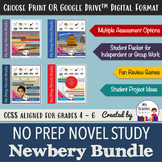No Prep Novel Study: When You Reach Me (Print or DIGITAL)
- PDF
- Google Apps™
- Easel Activity

What educators are saying
Also included in
- This 4th, 5th, and 6th grade bundle features novel studies for four Newbery Award winning books. The books cover a range of characters, settings, and literary styles, and are CCSS aligned for fourth, fifth, and sixth grade. Each item gives you the option to use printed materials or digital assignmenPrice $46.25Original Price $57.80Save $11.55
Description
This is a 120+ page, Common Core aligned, complete novel study for When You Reach Me by Rebecca Stead. This NO PREP book study teaching unit has everything that you will need to teach and assess the novel. The table of contents makes finding information quick and easy. ALL ANSWER KEYS ARE INCLUDED.
The student packet is divided into 4 sections. Each section contains vocabulary work, questions about figurative language, synonyms and antonyms, reading comprehension questions, and discussion questions. There is a quiz for each section as well. The sections are divided as follows:
- Section 1: Things You Keep in a Box – The Winner's Circle pg. 1-42
- Section 2: Things You Keep Secret – Things You Pretend pg. 43-91
- Section 3: Things that Crack – Things You Realize pg. 92 – 145
- Section 4: Things You Beg For – Parting Gifts pg. 146 – 197
GO DIGITAL! Choose printed or paperless resources! The student packet, quizzes, final exam are available as Google Drive files. A vocabulary and definitions list is also included to allow you to easily import into Flippity, Kahoot, Quizlet, etc. to create digital flashcards or word games.
••••••••••••••••••••••••••••••••••••••••••••••••••••••••••••••••••••••••••••••••••••••••••••••••••••••••••
⮕⮕⮕Planning on purchasing multiple copies or additional resources?
⚡⚡⚡Save money with a Custom Bundle!
⮕⮕⮕Looking for a different title or a lesson targeted to a specific standard?
⚡⚡⚡Request a Product! We'll create a product specifically for you. There's no commitment to buy, but if you purchase within the first 24 hours, you'll receive the product at 50% off!
••••••••••••••••••••••••••••••••••••••••••••••••••••••••••••••••••••••••••••••••••••••••••••••••••••••••••
Included in this novel study:
Introductory and Informational Materials:
- Teaching Notes
- CCSS Checklists for grades 5 – 6
Vocabulary Building Materials:
- Vocabulary Master List (digital option)
- "Mark My Words” Student Vocabulary Bookmark
- Word Wall Cards
- Vocabulary and Definition Cards
- Final Vocabulary Quiz (matching, answer key included)
Student Packet (digital option) (divided into 4 sections) featuring:
- Vocabulary
- Chapter Questions
- Focused Instruction on Synonyms/Antonyms and Figurative Language
- Discussion Questions
- Student Projects
Easy to Grade Assessments:
- Vocabulary Quiz (matching)
- (4) Section Quizzes (m/c) (digital option-Google Forms)
- Comprehensive Quiz (m/c) (digital option-Google Forms)
- Rigorous, Evidence-Based Final Exam with PARCC-style questions (m/c) (digital option-Google Forms)
Activities Included in this Book Study:
- When You Reach Me Question and Answer Dice Game
Common Core Standards utilized with this unit:
- R.L. 5.1, 5.2, 5.3, 5.4, 5.10
- R.L. 6.1, 6.2, 6.3, 6.4, 6.5, 6.6, 6.10
- L. 5.4, 5.4a, 5.4c, 5.5, 5.5a, 5.5b, 5.5c
- L. 6.4, 6.4a, 6.4b, 6.4c, 6.4d, 6.5, 6.5a
Skills addressed in this book study guide include:
- determining word meaning from context clues or a dictionary
- identifying and explaining the meaning of figurative language
- synonyms and antonyms
- identify narrator
- identify point of view and understand how the POV contributes to the plot
- describe setting
- identify the conflict(s) in a story
- identify the climax of a story
- make predictions
- providing textual evidence to support an answer
- interpreting the feelings of a character
- compare and contrast
- identify foreshadowing
- give reasons to support an opinion
- identify theme(s)
- identify genre
- summarize/describe events
__________________
Just looking for assessments?
Purchase the section quizzes as a stand-alone product here.
Purchase the comprehensive quiz as a stand-alone product here.
Purchase the final exam as a stand-alone product here.
★ ★ ★ ★ ★ ★ ★ ★ ★ ★ ★ ★ ★ ★ ★ ★ ★ ★ ★ ★ ★ ★ ★ ★ ★ ★ ★ ★ ★ ★ ★ ★ ★ ★ ★ ★ ★
Questions or comments? Contact My Reading Resources directly at: myreadingresources@yahoo.com.
★ ★ ★ ★ ★ ★ ★ ★ ★ ★ ★ ★ ★ ★ ★ ★ ★ ★ ★ ★ ★ ★ ★ ★ ★ ★ ★ ★ ★ ★ ★ ★ ★ ★ ★ ★ ★
©My Reading Resources. All rights reserved. Purchase of this unit entitles the purchaser the right to reproduce the pages in limited quantities for classroom use only. Duplication for an entire school, an entire school system, Outschool, or commercial purposes is strictly forbidden without written permission from the publisher.
Copying any part of this product and placing it on the Internet in any publicly accessible (not password protected) form (even a personal/classroom website) is strictly forbidden and is a violation of the Digital Millennium Copyright Act (DMCA). These items can be picked up in a Google search and then shared worldwide.







